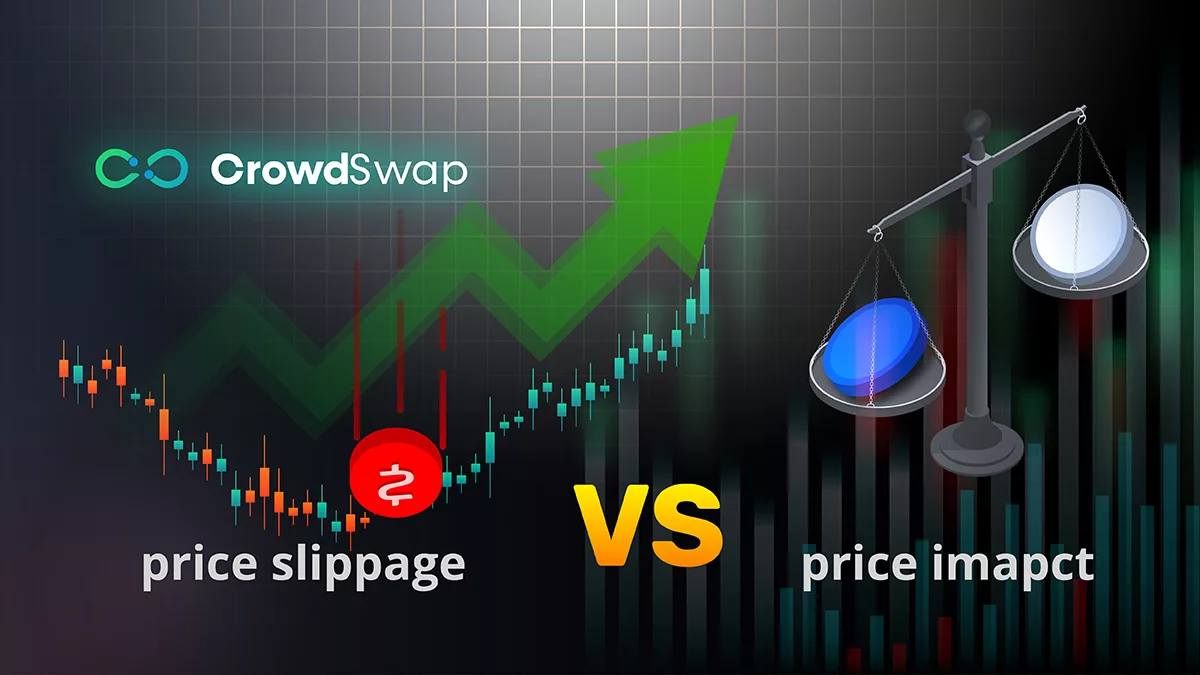Price impact and price slippage have always sparked debate among DeFi users and experts. Why are these two so often discussed, you might wonder? It’s simple: they both affect how traders perform in liquidity pools. Generally, in a liquidity pool, there’s a “constant” or “formula” that defines the ratio between token pairs (like USDC/MATIC). This means the value of each token in the pool should maintain a specific balance with its pair (we’ll dive into this more below).
But before we explore “Price Impact vs. Price Slippage” and how these constants work, let’s cover the basics.
What is Price Impact in Liquidity Pools?
Price impact refers to the change in a token’s price resulting from the size of a trade within a liquidity pool. A liquidity pool is a collection of tokens held in a smart contract, designed to provide liquidity for trading on decentralized exchanges, making it easy for users to swap between different tokens. A smart contract is a self-executing program on a blockchain that automatically enforces the terms of an agreement when certain conditions are met. When a trade is large compared to the total liquidity in the pool, it can have a significant effect on the token’s price.
Example of Price Impact
Imagine an “X token” paired with a “Y token” to form an XY liquidity pool, with one token often being a stablecoin. Liquidity providers deposit their X and Y tokens into the pool, creating a marketplace for people to buy and sell these tokens.
Liquidity pools usually follow a rule called X * Y = K (this formula aims for a 50:50 value split of each token in the pool). This built-in rule keeps the pool balanced and prevents chaos. The smart contract managing the pool automatically adjusts the values of the tokens after each trade to maintain this balance.
According to this rule, if everything is stable, the value of each token in the pool stays equal to its pair, thanks to the constant formula we mentioned earlier. However, liquidity pools are still a type of market, and they follow the basic laws of supply and demand. This is where price impact comes into play. If someone buys or sells a significant amount of X or Y tokens, the balance set by the constant can get disrupted. That’s when we experience price impact in a liquidity pool.
For example, if a trader wants to buy $1,000 worth of X tokens, the number of X tokens in the pool decreases. This reduction makes the remaining X tokens more valuable to other traders.
But how does this work?
As soon as X tokens are removed from the pool, the smart contract automatically adjusts the ratio to maintain the constant value. With fewer X tokens available, the value of X tokens goes up, while the value of Y tokens goes down because there are now more of them.
X Tokens: Quantity ⬇️ – Value 🔼
Y Tokens: Quantity 🔼 – Value ⬇️
In this way, the smart contract does some quick math to ensure the total value of each token balances itself against the other, keeping the liquidity pool stable.
What is Price Slippage?
Price slippage acts as a safety measure for traders, like a warning box that pops up during a trade to alert you. In liquidity pools, and partially due to price impact, the prospect of “you sneeze, you lose” has risen, as the value of token pairs can change quickly. This can lead to what’s known as slippage, where the final trade price ends up different from the quoted price — and it’s not always a bad thing!
However, most of the time, price slippage can result in having to spend a bit more to complete a trade than expected. Before a trade goes through, the slippage setting appears, allowing traders to decide how much price difference they’re willing to accept for that trade.
But what actually causes price slippage in an XY automated market maker (AMM)?
An AMM is a type of decentralized exchange that uses algorithms to automatically set and adjust token prices based on supply and demand in a liquidity pool. In an AMM, several factors can contribute to price slippage:
- Block Confirmation Times: From the moment you place an order until it’s confirmed on the blockchain, some time passes. During this period, other trades and price impacts can cause the price to change, resulting in slippage.
- Volume: Liquidity pools with lower total value locked (TVL) are more sensitive to price impacts, making them more prone to price slippage. However, it’s important to note that slippage isn’t always directly caused by price impact.
By understanding these factors, traders can better manage slippage and make more informed trading decisions.
Example of Price Slippage
Imagine you want to buy 100 X tokens from a liquidity pool using an automated market maker. When you initiate the trade, the quoted price for 1 X token is $10. So, you expect to pay $1,000 in total.
However, during the time it takes for your transaction to be confirmed on the blockchain, other traders also make trades that affect the price of X tokens. By the time your transaction is processed, the price of X tokens has increased to $10.50 due to these other trades.
As a result, instead of paying the expected $1,000, you end up paying $1,050 for the same 100 X tokens. This difference of $50 is due to price slippage — the difference between the expected price and the actual price you pay because of changes in the market conditions while your transaction was being processed.
Price Impact vs. Price Slippage
While both price impact and price slippage affect the prices of X and Y tokens in a liquidity pool and can be frustrating for traders, they occur for different reasons.
Price impact is directly caused by the actions of a trader. When tokens are added to or removed from a liquidity pool, the prices of the X and Y tokens adjust accordingly. This is an external effect resulting from individual trading actions.
Price slippage, on the other hand, results from broader market movements and other factors, as explained earlier. It occurs when the final price of a trade differs from the quoted price due to market fluctuations during the transaction process.
Interestingly, in pools with lower total value locked, it’s often true that “one trader’s price impact can become another’s price slippage”!
Trade Effortlessly
Ready to dive deeper? Our crypto exchange is simple and user-friendly, making trading a breeze
Take Away
There’s no avoiding the numbers when it comes to price impact and slippage, but there are ways to minimize their effects. If you’re concerned about these factors when choosing a liquidity pool, opt for pools with higher volumes, as they tend to be more stable. It’s also crucial to research DeFi projects before investing in their pools to distinguish between reputable ones and potential scams.
Learn More: How to Identify a Scam Token in DeFi?
At CrowdSwap, we take steps to minimize price impacts before launching new pools. We focus on projects with reliable and transparent smart contracts and ensure that new markets start with reasonable TVL to reduce the risk of price slippage and other internal issues.
FAQ
What is the difference between price impact and price slippage in a liquidity pool?
Price impact refers to the change in a token’s price due to the size of a trade within a liquidity pool. It’s an immediate effect caused by the actions of a trader buying or selling a significant amount of tokens.
Price slippage, on the other hand, occurs when the final price of a trade is different from the quoted price due to market movements during the transaction process.
While price impact is a direct result of a trade’s size relative to the pool’s liquidity, slippage is influenced by broader market conditions and the time it takes for a transaction to be confirmed on the blockchain.
How can I minimize price impact and slippage when trading in liquidity pools?
To minimize price impact, consider trading in liquidity pools with higher total value locked (TVL), as these pools have more tokens and are less sensitive to large trades.
For reducing slippage, check the slippage tolerance settings before confirming a trade. This allows you to set the maximum price difference you are willing to accept. It’s also beneficial to trade during times of lower volatility when prices are less likely to change drastically.
Why does price slippage occur more frequently in low-liquidity pools?
Price slippage occurs more frequently in low-liquidity pools because these pools have fewer tokens available. When a trade is made in a low-liquidity pool, even small transactions can significantly affect token prices due to the limited supply. This makes the final price of a trade more likely to differ from the quoted price, resulting in slippage. To avoid this, it’s recommended to trade in pools with higher liquidity, where the impact of individual trades is less pronounced.













